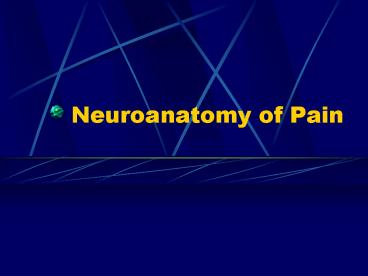Neuroanatomy of Pain - PowerPoint PPT Presentation
1 / 26
Title:
Neuroanatomy of Pain
Description:
From reticular formation to thalamus. Behavioral and emotional aspects of pain ... Reticular Formation. Thalamus. Cortex. Structures involved with Descending ... – PowerPoint PPT presentation
Number of Views:521
Avg rating:3.0/5.0
Title: Neuroanatomy of Pain
1
Neuroanatomy of Pain
2
Introduction
- What is pain?
- An unpleasant sensory and emotional experience
associated with actual or potential tissue
damage, or described in such terms as tissue
damage
3
Introduction
- Pain is subjective
- Does pain have a purpose?
- Types of Pain
- Acute Pain
- Chronic Pain
- Referred Pain
- Radiating
4
Neurophysiology of Pain
- Afferent Peripheral Receptor Types
- Special Receptors
- Visceral Receptors
- Deep Receptors
- Superficial Receptors
5
Afferent Peripheral Receptors
- Special
- Transmit taste, sight, smell
- Visceral Receptors
- Transmit hunger, distention, nausea
- Deep
- Kinesthesia, joint position sense, deep pressure
and pain - Muscle -- GTOs, muscle spindles
- Articular Structures fast and slow adapting
mechanoreceptor and nociceptors
6
Afferent Peripheral Receptors
- Superficial
- Warm/cold, touch, pressure, itch and pain from
skin level - 3 categories
- Mechanorecptors
- Thermoreceptors
- Nociceptors
7
Mechanorecepetors
- Mechanical stimuli
- Touch, pressure, stroking
8
Mechanorecpetors
- Mechanical stimuli
- Touch, pressure, stroking
- Fast-adapting Receptors
- Pacinian Corpuscles
- Meissner Corpuscles
- Respond to pressure and touch very quickly
9
Mechanorecpetors
- Mechanical stimuli
- Touch, pressure, stroking
- Fast-adapting Receptors
- Slow-adapting Receptors
- Merkel Cell Ending
- Ruffinni Endings
- Stimulated by sustained stimuli
10
Thermoreceptors
- Respond to temp and temp changes
- Slow-adapting structures
- Warm vs cold receptor firing
11
Nociceptors
- Transmit pain impulses
- Described as free nerve ending
- Stimulated by
- Mechanical
- Chemical
- Thermal
12
What is the initial response to pain stimulus?
13
Release of Chemical Mediators
Cell trauma
- Pain always begin with chemical response
Release dopamine and NE from Cell membrane
Activates phospholipase
Converted to prostaglandin or bradykinin
Release Arachidonic Acid
14
First Order Neurons
- Transmit sensory information from receptors to
dorsal horn - Types of Primary Receptors in Pain Management
- A-delta
- A-beta
- C fibers
15
All Types of First-Order Neurons
16
Closer Analysis of those Receptors Involved in
Pain Management
- A-delta
- Large, lightly myelinated
- Conduction velocities
- Respond to?
- Protopathic pain (AKA Primary Hyperalgesia)
17
Closer Analysis of those Receptors Involved in
Pain Management
- A-delta
- A-beta
- Large, myelinated
- Conduction velocities
- Respond to?
18
Closer Analysis of those Receptors Involved in
Pain Management
- A-delta
- A-beta
- C-fibers
- Unmyelinated
- Conduction velocity
- Respond to
- Epicritic pain (AKA Secondary Hyperalgesia)
19
Dorsal Horn of the Spinal Cord
20
Spinal Cord Level
- SC divided into several Laminae
- A-delta and C terminate in Laminae I and II
- A-delta has input in V also
- Laminae I
- Laminae II
- Laminae III and IV
- Laminae V
21
Second Order Neurons
- Synapse with Laminae I and V cross midline
- Synapse with Spinothalmic Tract
- Immediate warning of presence, location and
intensity of pain
22
Second Order Neurons
- Spinothalamic Tract
- Receives info from A-delta in Laminae I and V
- Classification of ST Tract Cells
- Low-threshold
- Wide dynamic range
- High threshold
- Thermosensitive
23
Spinoreticulothalamic Tract (FYI)
- Input from Laminae VII and VIII
- Mostly from C-fibers
- A bilateral tract
- From reticular formation to thalamus
- Behavioral and emotional aspects of pain
24
Third and Fourth Order Neurons
- Second order synapse to higher brain center
- 3rd reticular formation to thalamus
- 4th between and within higher brain centers
25
Higher Brain Centers
- Reticular Formation
- Thalamus
- Cortex
26
Structures involved with Descending Control of
Pain
- Periaqueductal Grey Matter
- Nucleus Raphe Magnus
- Corticospinal Tract































